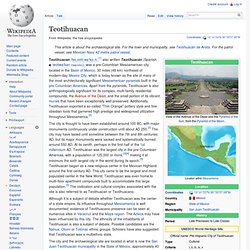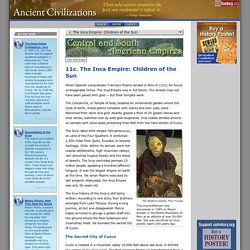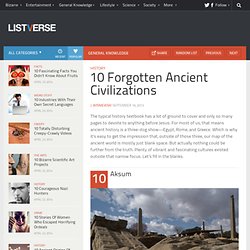

Teotihuacan. Coordinates: Teotihuacan /teɪˌoʊtiːwəˈkɑːn/,[1] also written Teotihuacán (Spanish teotiwa'kan ), was a pre-Columbian Mesoamerican city located in the Basin of Mexico, 30 miles (48 km) northeast of modern-day Mexico City, which is today known as the site of many of the most architecturally significant Mesoamerican pyramids built in the pre-Columbian Americas.

Apart from the pyramids, Teotihuacan is also anthropologically significant for its complex, multi-family residential compounds, the Avenue of the Dead, and the small portion of its vibrant murals that have been exceptionally well-preserved. Additionally, Teotihuacan exported a so-called "Thin Orange" pottery style and fine obsidian tools that garnered high prestige and widespread utilization throughout Mesoamerica.[2] Name[edit] This naming convention led to much confusion in the early 20th century, as scholars debated whether Teotihuacan or Tula-Hidalgo was the Tollan described by 16th–century chronicles. History[edit] Zenith[edit] The Inca Empire: Children of the Sun. When Spanish conquistador Francisco Pizarro landed in Peru in 1532, he found unimaginable riches.

The Inca Empire was in full bloom. The streets may not have been paved with gold — but their temples were. The Coricancha, or Temple of Gold, boasted an ornamental garden where the clods of earth, maize plants complete with leaves and corn cobs, were fashioned from silver and gold. Nearby grazed a flock of 20 golden llamas and their lambs, watched over by solid gold shepherds. Inca nobles strolled around on sandals with silver soles protecting their feet from the hard streets of Cuzco. The Mountain Institute, West Virginia This mummified girl was discovered in 1995 on Mount Ampato in the Andes Mountains of Peru at an altitude of over 20,000 feet. The Inca called their empire Tahuantinsuyu, or Land of the Four Quarters. The true history of the Inca is still being written. The Sacred City of Cuzco Cuzco is nestled in a mountain valley 10,000 feet above sea level. How was this done? Maya - Facts & Summary. The Classic Period, which began around A.D. 250, was the golden age of the Maya Empire.

Classic Maya civilization grew to some 40 cities, including Tikal, Uaxactún, Copán, Bonampak, Dos Pilas, Calakmul, Palenque and Río Bec; each city held a population of between 5,000 and 50,000 people. At its peak, the Maya population may have reached 2,000,000. Excavations of Maya sites have unearthed plazas, palaces, temples and pyramids, as well as courts for playing the ball games that were ritually and politically significant to Maya culture. Maya cities were surrounded and supported by a large population of farmers.
Though the Maya practiced a primitive type of “slash-and-burn” agriculture, they also displayed evidence of more advanced farming methods, such as irrigation and terracing. The Maya were deeply religious, and worshiped various gods related to nature, including the gods of the sun, the moon, rain and corn. Serious exploration of Classic Maya sites began in the 1830s. 10 Forgotten Ancient Civilizations. History The typical history textbook has a lot of ground to cover and only so many pages to devote to anything before Jesus.

For most of us, that means ancient history is a three-dog show—Egypt, Rome, and Greece. Which is why it’s easy to get the impression that, outside of those three, our map of the ancient world is mostly just blank space. But actually nothing could be further from the truth. Plenty of vibrant and fascinating cultures existed outside that narrow focus. What is the Planet Nibiru? Sumeria, Ancient Sumeria (Sumer), A history of Ancient Sumer Including its Contributions.
Ancient Civilizations.